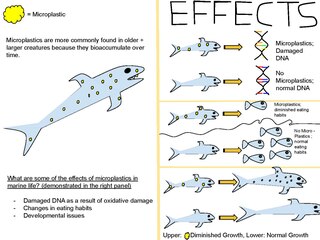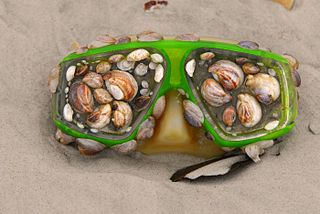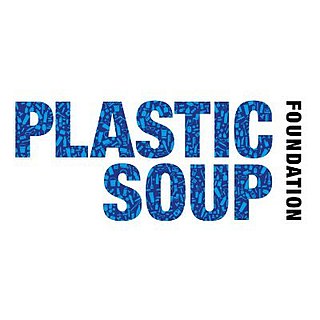Related Research Articles

Marine pollution occurs when substances used or spread by humans, such as industrial, agricultural and residential waste, particles, noise, excess carbon dioxide or invasive organisms enter the ocean and cause harmful effects there. The majority of this waste (80%) comes from land-based activity, although marine transportation significantly contributes as well. It is a combination of chemicals and trash, most of which comes from land sources and is washed or blown into the ocean. This pollution results in damage to the environment, to the health of all organisms, and to economic structures worldwide. Since most inputs come from land, either via the rivers, sewage or the atmosphere, it means that continental shelves are more vulnerable to pollution. Air pollution is also a contributing factor by carrying off iron, carbonic acid, nitrogen, silicon, sulfur, pesticides or dust particles into the ocean. The pollution often comes from nonpoint sources such as agricultural runoff, wind-blown debris, and dust. These nonpoint sources are largely due to runoff that enters the ocean through rivers, but wind-blown debris and dust can also play a role, as these pollutants can settle into waterways and oceans. Pathways of pollution include direct discharge, land runoff, ship pollution, bilge pollution, atmospheric pollution and, potentially, deep sea mining.

The Great Pacific garbage patch is a garbage patch, a gyre of marine debris particles, in the central North Pacific Ocean. It is located roughly from 135°W to 155°W and 35°N to 42°N. The collection of plastic and floating trash originates from the Pacific Rim, including countries in Asia, North America, and South America.

Plastic pellet pollution is a type of marine debris originating from the plastic particles that are universally used to manufacture large-scale plastics. In the context of plastic pollution, these pre-production plastic pellets are commonly known as 'nurdles'. These microplastics are created separately from the user plastics they are melted down to form, and pellet loss can occur during both the manufacturing and transport stages. When released into the open environment, they create persistent pollution both in the oceans and on beaches. About 230,000 tonnes of nurdles are thought to be deposited in the oceans each year, where they are often mistaken for food by seabirds, fish and other wildlife. Due to their small size, they are notoriously difficult to clear up from beaches and elsewhere.

A garbage patch is a gyre of marine debris particles caused by the effects of ocean currents and increasing plastic pollution by human populations. These human-caused collections of plastic and other debris, cause ecosystem and environmental problems that affect marine life, contaminate oceans with toxic chemicals, and contribute to greenhouse gas emissions. Once waterborne, marine debris becomes mobile. Flotsam can be blown by the wind, or follow the flow of ocean currents, often ending up in the middle of oceanic gyres where currents are weakest.

Marine plastic pollution is a type of marine pollution by plastics, ranging in size from large original material such as bottles and bags, down to microplastics formed from the fragmentation of plastic material. Marine debris is mainly discarded human rubbish which floats on, or is suspended in the ocean. Eighty percent of marine debris is plastic. Microplastics and nanoplastics result from the breakdown or photodegradation of plastic waste in surface waters, rivers or oceans. Recently, scientists have uncovered nanoplastics in heavy snow, more specifically about 3,000 tons that cover Switzerland yearly.

The environmental impact of the petroleum industry is extensive and expansive due to petroleum having many uses. Crude oil and natural gas are primary energy and raw material sources that enable numerous aspects of modern daily life and the world economy. Their supply has grown quickly over the last 150 years to meet the demands of the rapidly increasing human population, creativity, knowledge, and consumerism.

The North Atlantic garbage patch is a garbage patch of man-made marine debris found floating within the North Atlantic Gyre, originally documented in 1972. A 22-year research study conducted by the Sea Education Association estimates the patch to be hundreds of kilometers across, with a density of more than 200,000 pieces of debris per square kilometer. The garbage originates from human-created waste traveling from rivers into the ocean and mainly consists of microplastics. The garbage patch is a large risk to wildlife through plastic consumption and entanglement. There have only been a few awareness and clean-up efforts for the North Atlantic garbage patch, such as The Garbage Patch State at UNESCO and The Ocean Cleanup, as most of the research and cleanup efforts have been focused on the Great Pacific garbage patch, a similar garbage patch in the north Pacific.

Microplastics are fragments of any type of plastic less than 5 mm (0.20 in) in length, according to the U.S. National Oceanic and Atmospheric Administration (NOAA) and the European Chemicals Agency. They cause pollution by entering natural ecosystems from a variety of sources, including cosmetics, clothing, food packaging, and industrial processes.

The majority of environmental issues affecting Hawaii today are related to pressures from increasing human and animal population and urban expansion both directly on the islands as well as overseas. These include the unsustainable impacts of tourism, urbanization, implications of climate change such as sea level rise, pollution, especially marine plastic pollution, and invasive species.

Plastic pollution is the accumulation of plastic objects and particles in the Earth's environment that adversely affects humans, wildlife and their habitat. Plastics that act as pollutants are categorized by size into micro-, meso-, or macro debris. Plastics are inexpensive and durable, making them very adaptable for different uses; as a result, manufacturers choose to use plastic over other materials. However, the chemical structure of most plastics renders them resistant to many natural processes of degradation and as a result they are slow to degrade. Together, these two factors allow large volumes of plastic to enter the environment as mismanaged waste which persists in the ecosystem and travels throughout food webs.

Susan D. Shaw was an American environmental health scientist, marine toxicologist, explorer, ocean conservationist, and author. A Doctor of Public Health, she was a professor in the Department of Environmental Health Sciences at the School of Public Health at the State University of New York at Albany, and Founder/President of the Shaw Institute, a nonprofit scientific institution with a mission to improve human and ecological health through innovative science and strategic partnerships. Shaw is globally recognized for pioneering high-impact environmental research on ocean pollution, climate change, oil spills, and plastics that has fueled public policy over three decades. In 1983, with landscape photographer Ansel Adams, she published Overexposure, the first book to document the health hazards of photographic chemicals. Shaw is credited as the first scientist to show that brominated flame retardant chemicals used in consumer products have contaminated marine mammals and commercially important fish stocks in the northwest Atlantic Ocean. She became the first scientist to dive into the Gulf of Mexico oil slick following the 2010 BP Deepwater Horizon oil rig explosion to investigate the impacts of chemical dispersants used in response to the spill.

The plastisphere consists of ecosystems that have evolved to live in human-made plastic environments. All plastic accumulated in marine ecosystems serves as a habitat for various types of microorganisms, with the most notable contaminant being microplastics. There are an estimate of about 51 trillion microplastics floating in the oceans. Relating to the plastisphere, over 1,000 different species of microbes are able to inhabit just one of these 5mm pieces of plastic.

The fashion industry, particularly manufacture and use of apparel and footwear, is a significant driver of greenhouse gas emissions and plastic pollution. The rapid growth of fast fashion has led to around 80 billion items of clothing being consumed annually, with about 85% of clothes consumed in United States being sent to landfill.

Plastic Soup Foundation is a non-profit marine conservation organisation that aims to reduce plastic pollution. Established in 2011, Plastic Soup Foundation advocates towards imposing bans and/or voluntary phase-outs of microbeads in cosmetics at a global scale with the Beat the Microbead campaign.
The Shaw Institute, formerly the Marine & Environmental Research Institute, is a 501(c)(3) nonprofit scientific research organization based in Blue Hill, Maine and New York City. The institute conducts research into ocean pollution, flame retardants, microplastics and plastic pollution, sentinel species and climate change.
Tamara Susan Galloway is a British marine scientist and Professor of Ecotoxicology at the University of Exeter. She was appointed an Officer of the Order of the British Empire in the 2019 Birthday Honours.

Chelsea Marina Rochman is an American marine and freshwater ecologist whose research focuses on anthropogenic stressors in freshwater and marine ecosystems. Since September 2016, Rochman has been an assistant professor at the University of Toronto in the department of Ecology and Evolutionary Biology and a scientific advisor to the Ocean Conservancy.
Max Liboiron is a Canadian researcher and designer known for their contributions to the study of plastic pollution and citizen science.

Jenna Jambeck an American environmental engineer who is the Georgia Athletic Association Distinguished Professor of Environmental Engineering at the University of Georgia. Her research considers plastic pollution and efforts to address plastic waste. In 2022, she was appointed a MacArthur Fellow.

The Mediterranean Sea has been defined as one of the seas most affected by marine plastic pollution.
References
- 1 2 "Abigail Barrows". scholar.google.com. Retrieved 2022-01-09.
- 1 2 3 Kevin, Brian (2021-09-19). "In a Maine Fishing Village, a Microplastics Researcher Reenvisions Aquaculture". Down East Magazine. Archived from the original on 2021-09-21. Retrieved 2022-01-09.
- ↑ Lee, Vivian (2020-05-07). "An Unexpected Dinner Guest: Marine Plastic Pollution Hides a Neurological Toxin in Our Food". The New York Times. ISSN 0362-4331 . Retrieved 2022-01-09.
- ↑ Carne, Gabriella (2017-02-10). "Abi Barrows - Fighting Plastic Pollution with Citizen Science". scu.edu/ethics/. Archived from the original on 2019-12-08. Retrieved 2019-01-12.
- ↑ Ortiz, Victoria. "Oceanic Society Expedition". adventurescientists.org. Retrieved 2019-01-12.
- ↑ "What should be prioritized to prevent plastic pollution? Science, education or legal policy? – | be Waste Wise" . Retrieved 2022-01-09.
- ↑ "Marine Scientist Abby Barrows talk: Microplastic Pollution in Aquatic Environments". PenBay Pilot. Retrieved 2022-01-09.
- ↑ "Abby Barrows - Be Waste Wise". wastewise.be. 2016-05-01. Archived from the original on 2016-05-12. Retrieved 2019-01-12.
- ↑ "Marine environment microfiber contamination: Global patterns and the diversity of microparticle origins". scholar.google.com. Retrieved 2022-01-09.
- ↑ "Be Waste Wise". wastewise.be. Retrieved 2019-01-12.
- ↑ "Global Microplastics Initiative". adventurescientists.org. Retrieved 2019-02-15.
- ↑ "Citizen Adventurers". www.npr.org. Retrieved 2019-01-19.
- ↑ Difrisco, Emily. "Unseen Plastics In Our Water". www.earthisland.org. Retrieved 2019-01-19.
- ↑ Barrows, Abigail P. W.; Neumann, Courtney A.; Berger, Michelle L.; Shaw, Susan D. (2017-03-02). "Grab vs. neuston tow net: a microplastic sampling performance comparison and possible advances in the field". Analytical Methods. 9 (9): 1446–1453. doi:10.1039/C6AY02387H. ISSN 1759-9679.
- ↑ Barrows, Abigail P. W.; Christiansen, Katie S.; Bode, Emma T.; Hoellein, Timothy J. (2018-12-15). "A watershed-scale, citizen science approach to quantifying microplastic concentration in a mixed land-use river". Water Research. 147: 382–392. doi:10.1016/j.watres.2018.10.013. ISSN 0043-1354.